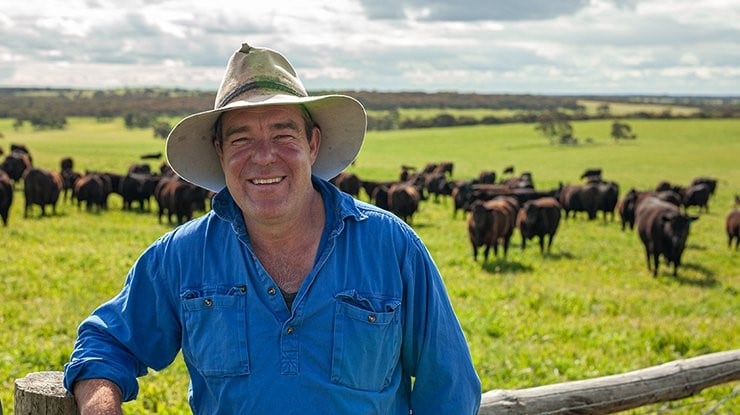EBVs and carcase feedback help South Australian producer improve beef cattle herd

Theme: Economic resilience
Priorities: Profitability across the value chain; Farm, feedlot and processor productivity and cost of production.
Producer: Andrew Johnson, Mount Boothby Pastoral Company
Location: Tintinara, South Australia
KEY POINTS
- Andrew Johnson uses the carcase feedback provided by MSA to improve herd management decisions.
- These decisions relate to nutrition, genetics and livestock handling.
Using estimated breeding values (EBVs) and carcase feedback to refine his herd has helped South Australian beef producer, Andrew Johnson, achieve high rates of compliance to Meat Standards Australia (MSA).
At ‘Mount Boothby’ near Tintinara, South Australia, Andrew runs a mixed-farming business comprising beef, sheep, pigs and cropping operations across an aggregation of 7,000ha.
A registered MSA producer for 10 years, Andrew was awarded the 2019 Most Outstanding MSA Producer in SA for Band 2 producers, having achieved MSA compliance of 92.7% and an average MSA Index of 64.69.
Andrew said he uses the carcase feedback provided by MSA, accessed through www.mymsa.com.au(External link), to improve herd management decisions to meet supermarket specifications and achieving outstanding compliance.
“The MSA program helps us see what cattle are meeting market specifications, allowing us to achieve performance targets, fostering a return on investment.”
myMSA provides producers with the opportunity to benchmark their compliance and MSA Index performance with national, state and regional performances. It also provides a suite of easy to use reports to look at individual carcase attributes, with the functionality to download carcase data to import into on-farm systems.
“We run a self-replacing herd of 400 Angus females, turning off milk vealers early, targeting around 400kg liveweight, and weaning the rest to grow out and finish to a heavier carcase, and sold at 12 months,” Andrew said.
“They’re run predominately on improved lucerne-based pastures with a mix of clover and grasses, providing a combination of protein and energy. We supplementary feed hay when necessary.
“Matching pasture production and feeding regimes to manage lactation intervals in good seasons allows us turn off animals earlier and heavier.”
Andrew said genetics also played a key role in meeting performance targets.
“We are constantly tailoring and targeting our breeding herd based on EBVs, with calving ease, eye muscle, development, weaning weights and carcase weights a key focus when selecting genetic stock,” Andrew said.
Andrew also recognises the importance of low-stress stock handling to achieve better eating quality.
Andrew encourages other producers to get on board with MSA and make the most of the valuable information and feedback data provided.
Categories: Economic resilience